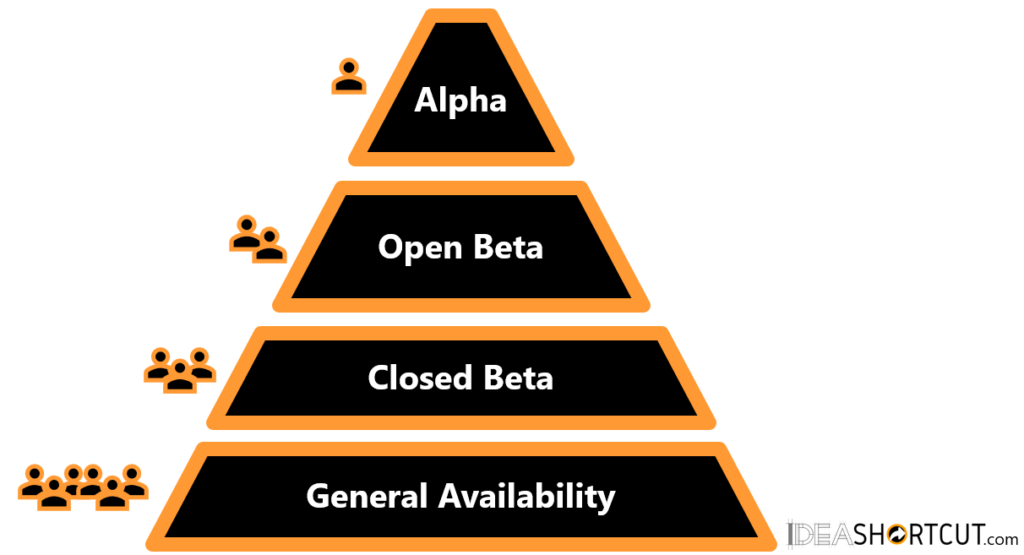This is the third of three articles that explore the challenges of using Failing Fast strategies in enterprise. On the previous article we covered the problems B2B companies face when trying to failing fast. On this article we’ll cover a set of coping mechanisms to safe guard the use of Fail Fast strategies in enterprise.
Hyper focus
The first problem that we discussed on the previous article were the tendency for Fat MVPs to cater for enterprise level requirements.
Restricting Scope
Regardless of the field, a good way to avoid risk impacts is segregating scope. A good way of restricting the scope of MVPs is to focus on a niche within a company’s usual targeting marketing segment. Let’s pick back on the example of our last article, Sleek Groom a wedding suits company, that wanted to start a wedding garments franchise business, but they lacked some products to provide a complete offer. Instead of scoping a franchise business for all Groom personas the luxurious groom, budget groom, “I want marry on a bathing groom suit groom”, Sleek Groom could focus on one of these in particular. Let’s say the luxurious groom, which could potentially drive the highest ROI.
Single Threaded Leadership
MVPs can be heavy in cost but also in development time. Restricting scope can help both on the cost and development time. Nonetheless other things may impact delivery timelines of new products, namely resource availability. Innovation time to market is key for success and sharing a team to focus on pre-existing products and breakthrough new ones may cause bottlenecks. Prioritization exercises for split teams may be extremely hard to do, as the innovation process carries risks. It’s often hard to make the case of potential future returns vs. sure less risky money, even if future sustainability is at stake.
I’ve recently came across a book Working Backwards: Insights, Stories, and Secrets from Inside Amazon that depicts a number of strategy guidelines followed at Amazon and, that in authors view, helped established Amazon’s success. One of the concepts addressed is Single Threaded Leadership and how that helped Amazon put their foot on the gas of innovation.
Single Threaded Leadership’s main goal is to ensure that there is a set of resource whose sole focus is to deliver against a strategic need. These resources have the autonomy to deliver the initiative and have virtually no dependencies from other teams. There are several side considerations around Single Threaded Leadership, which we will address in more detail on another post.
By having dedicated resources to pursue a strategic goal organizations ensure they have no bottle necks in MVP development. Companies are able to be light, nimble and get to market in shortest possible fashion.
Finding investment outside existing sales pipeline

Getting back on the scope segregation stance from the first point, it can also be applied into other contexts. Scope segregation may come in different shapes or forms, but when it comes to money it generally means finding a separate money pot. When companies position MVP products as cornerstones to their P&L, they risk having a side investment ruining business unit.
Alternatively MVP products should be seen as segregated investments with well defined budgets, which don’t depend on future sales for other products. This allow companies to limit the impact of unsuccessful MVPs and fail fast. However readers may still ask the question: where does the budget come from?
Bet with money in the bank
Even though banking on future sales may be a risky game, using prior margins is more then fair game. Companies with strong focus in innovation are likely doing this already: investing earnings in ideas, that in time may allow the business to grow further.
By using excedents it ensures the company won’t get into the red, also forces a budget to have boundaries.
Partnerships
What if excess can’t carved from P&L? Then one can make the exercise of looking into somebody else’s pocket! Partnership can be a good way of sharing risk and investment. It often means sharing the returns, which often has it’s drawbacks but also has one major benefit: more stakeholders invested in driving successful MVPs.
Partnerships can be formed with companies that offer complementary products to each other or even with competitors. In the first case, companies can collaborate with each other to complement their product lines.
Let’s pick back again on the example of our last article, Sleek Groom. Sleek Groom could close the gap on their product line by partnering with Groom Walk, a shoe manufacturer. The joint venture could cooperate on a new full wedding garments line.
Partnerships can even be forged amongst competitors, companies may decide to cooperate in common gaps and compete with their main products. Using the example again, Sleek Groom and Elegant Future Husband may both do suits but agree to split the risk on creating shoes to fill a gap that both have.
Find lead customer(s)
A special case of forging partnerships is forge them directly with customers. Sometimes companies are able to perfectly align their product roadmap with the immediate necessities of their customer or group of customers. The needs of the customers may align with their strategic goals so well, that they could be willing to sponsor product development. Crowd funding is a great example for this in the B2C world, but the same logic may apply to B2B as well.
Companies and customers need to find common interests, transparency and feedback often helps on the process establishing the partnership. In addition, this communication flow is also a great way to gather feedback and shape products that fit real customer needs.
Managing Expectations
Beyond de-risking the impact of running fail fast strategies in company’s P&L, managing the customer’s expectation can be challenging. As we’ve seen on the previous article, not addressing your B2B customer expectations may have reputation, or even legal implications.
A good way to align product development with the customer’s expectations is to label the different maturity stages of the product. Guru99 has a great description of different types of product testing can be used on a product development lifecycle. These testing phases can be used as labels for the product. Each label has an associated expectation based on the level of its maturity. The article’s example is particularly focused on software development, but the concept applies to any product development field.

For the interest of this article let’s talk about Alpha, Closed Beta and Open Beta product testing.
Alphas
Alpha product testing should be done as early as possible. As soon a product development process produces any palpable or measurable results, alpha testing can begin.
This type of testing is usually done by specialized friendly stakeholder’s on the customers organization (or specialized friendly users in the B2C case). The objective is to identify any possible functional issues (aka bugs in software development), before releasing another version of the final product to end users.
The goal of the tester should be to identify the tasks that a typical user might perform and test them. A feedback loop should be established by the product manager to ensure further iterations can be developed, addressing the assessments given by the testers.
Closed Betas
Unlike alpha testing, beta testing is performed by real end users in an environment that is expected to be as “real” as possible. It can be considered as a form of external User Acceptance Testing.
Closed Betas are intended for only a restrict set of customers, with a controlled set of end-users. Even though beta stages are mainly focused on product quality, reliability and robustness, user experience and functional aspects may also be covered.
Most of the issues or feedback is collected from Beta testing will likely be implemented in future versions of the product, but at the end of the stage it’s important to establish that the product is ready for real time users.
Open Betas
After running beta testing with one or more of customers and after accessing that minimal quality has been established for wider use, companies may choose to go from closed beta testing to open beta testing. This enables all customers to test the results of a company’s innovation effort. This can be beneficial for customers to position as early adopters of products, but also provides great feedback for companies to develop the next versions of their product to cater a wider audience.
Establishing a sequence of product iterations, companies align the customer expectations with the different stages of the product. Establishing this alignment in the scopes of work and in any contractual touchpoints, companies introduce transparency in the product’s acceptance process. As a consequence companies provide themselves enough room for error, which inevitable in any innovation process.

